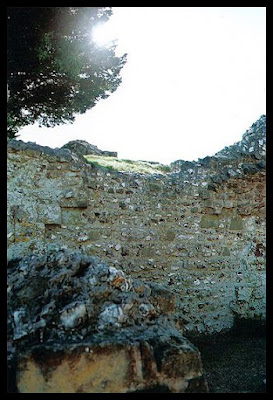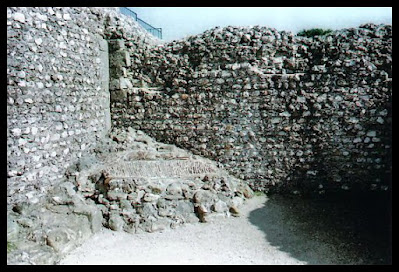Two miles north of the modern-day Salisbury, Old Sarum is the site of the earliest settlement of Salisbury, and is situated upon a much earlier Iron Age Hillfort, the outer banks of which were created around 500 BC. However, archaeological remains reveal that the site has been occupied since Neolithic times, around 5,000 years ago. Roughly oval in shape, the hillfort consists of a bank and ditch with an entrance at the east side.
It
was held by the Romans as a military station during their occupation of
Britain between AD 43 and AD 410, which they named Sorviodunum, and was
also later used by the Saxons. It was shortly after the Norman conquest
that the motte and bailey castle in the centre of the hillfort was
built, around 1069. The town was then renamed and listed in the Domesday
Book as Sarisburia, from which the names Sarum and Salisbury are
derived. A cathedral and bishop's palace were constructed upon the site
between 1075 and 1092, and the cathedral (having suffered severe damage
from a storm just 5 days after consecration), was rebuilt and finally
completed between 1130 and 1139, along with a castle and stone Royal
Palace on the hill site.
After
relations between the castle guard and clerics of the cathedral broke
down, it was decided in 1219 by the then Bishop Richard Poore to rebuild
the cathedral some two miles to the south. A new settlement grew around
it, which eventually became the city of Salisbury.
Remains
of the castle keep and courtyard house walls are still extant on the
site. Very little of the cathedral remains, but the outline and
foundation stones can be seen.
Visiting
in September 2008, it didn't really grab me at the time, especially as I
had no prior knowledge about its history. However, after doing some research
and seeing an aerial view of the whole site, I realised just how
impressive it actually is. In the Google Earth image below, the remains
of the cathedral can clearly be seen in the north-west quadrant.
It was difficult to remember, or even find out, which parts of the castle were which. However, I eventually capitulated and sent off for an official English Heritage guidebook - being of the persuasion that if all else fails, read the instructions! ;)
The entrance is through the eastern gate, where the Gatehouse was. To the right of this is the Courtyard House, which is where some of the best remains are.
The two photos above are part of the guardroom. The courtyard also includes the Chapel of St Margaret, where the altar can still be seen in the photo below.
I'm not sure which part the photo below came from but I think it was still within the courtyard. It looks like the base of a stairwell, which is interesting.
Just outside the courtyard is the well, now suitably and safely covered.
The next port of call was the Keep situated at the west gate.
Then continuing to walk around to the southern ramparts.
Standing on the southern ramparts of the motte, above - very briefly, as I'm totally acrophobic - and looking across to Salisbury in the photo below, where the spire of Salisbury Cathedral can just be made out on the horizon at centre right.
Looking from the eastern end of the ramparts across to the keep and the Courtyard House, we can see how extensive they are. The keep included a massive postern tower, built to impress its authority on the landscape, which is no longer standing.
This section on the other side of the gatehouse is where there was a new hall, kitchen and bakehouse. Used for court hearings, the new hall may have also been used by the garrison men. The kitchen & bakehouse comprised three rooms, the largest of which contained three bread ovens.
And the view over the ramparts by the keep, showing the foundation remains of the cathedral below.
The cathedral foundations in the outer bailey with the motte in the background.
It's interesting to see where the arcade coloumns were situated, as seen in the cruciformed shapes on the grass. Next to the cathedral was the layout to the cloister, below.
And also the remains of the vestry and church treasury.
And finally, another view of the motte. Which concludes our tour. :)
It's odd because even now I still don't feel very enamoured about the site, especially as many of the photographs came out badly. It's certainly impressive and interesting and I should have loved it. Maybe if I went again I'd feel differently...or maybe not; some places are just like that!
Anyway, I'm glad I included it at last, lol. Next up, a stone! ;)
































No comments:
Post a Comment